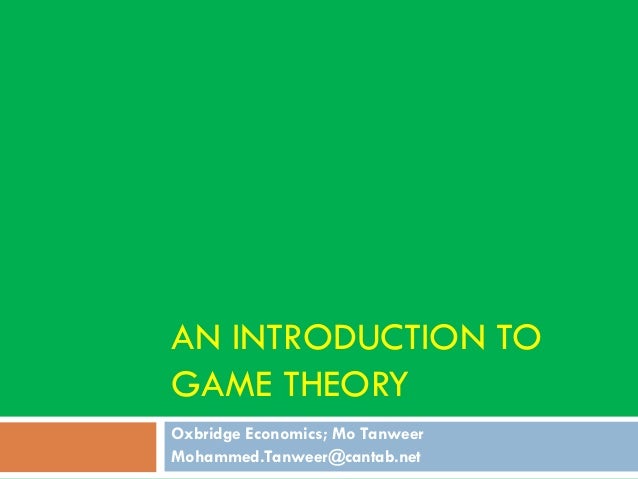Game Theory An Introduction Answers
Solution Manual An introduction to game theory. Universiteit van Amsterdam. Speltheorie 6012B0311Y.
Game Theory An Introduction Answers In Math
- The essential feature is that it provides a formal modelling approach to social situations in which decision makers interact with other agents. Game theory is a branch of applied mathematics that is often used in the context of economics. It studies strategic interactions between agents.
- Answer: This follows from the solution in part (b) above. For every type of person, the solution is ( )= 8 which is increasing in,and larger people have higher values of ¥ (d) Should any person drink more than one bottle of wine? Even the largest type of person with =6should only consume = 3 4 of a bottle of wine.
This comprehensive textbook introduces readers to the principal ideas and applications of game theory, in a style that combines rigor with accessibility. Steven Tadelis begins with a concise description of rational decision making, and goes on to discuss strategic and extensive form games with complete information, Bayesian games, and extensive form games with imperfect information. He covers a host of topics, including multistage and repeated games, bargaining theory, auctions, rent-seeking games, mechanism design, signaling games, reputation building, and information transmission games. Unlike other books on game theory, this one begins with the idea of rationality and explores its implications for multiperson decision problems through concepts like dominated strategies and rationalizability. Only then does it present the subject of Nash equilibrium and its derivatives.Game Theory is the ideal textbook for advanced undergraduate and beginning graduate students. Throughout, concepts and methods are explained using real-world examples backed by precise analytic material.

'The book aims to be precise and rigorous, yet accessible and reader-friendly, and, to a great extent, it does hit these apparently conflicting targets. The depth of the book is intermediate, with a conventional, yet clear, style of writing. It will please mainstream economists. It can help advanced undergraduates and also students at honors or master's levels.
It can also be used by PhD students seeking a fast, not so mathematized introduction to the field.' -Jose Rodriques-Neto, Economic Record. 'Steven Tadelis is a leading scholar in applied game theory, and his expertise shines through in this excellent new text.
Aimed at intermediate to advanced undergraduates, it presents and discusses the theory remarkably clearly, at both the intuitive and formal levels. One novel feature I like is its serious consideration of the decision theoretic foundations of game theory. Another is its transparent presentation of relatively recent topics and applications, such as reputations in asymmetric information games, legislative bargaining, and cheap talk communication.' —Steve Matthews, University of Pennsylvania.

Who should take this course?This course is an introduction to game theory. Introductory microeconomics (115 or equivalent) is required.
Intermediate micro (150/2) is not required, but it is recommended. We will use calculus (mostly one variable) in this course. We will also refer to ideas like probability and expectation.
Some may prefer to take the course next academic year once they have more background. Students who have already taken Econ 156b should not enroll in this class.Course Aims and Methods.Game theory is a way of thinking about strategic situations.

One aim of the course is to teach you some strategic considerations to take into account making your choices. A second aim is to predict how other people or organizations behave when they are in strategic settings. We will see that these aims are closely related. We will learn new concepts, methods and terminology.
A third aim is to apply these tools to settings from economics and from elsewhere. The course will emphasize examples. We will also play several games in class.Outline and Reading.Most of the reading for this course comes from the first ten chapters of Dutta or from the first two parts of Watson. There will be a reading packet for weeks 6-7.
The readings are not compulsory, but they will help back up the class material. About Professor Ben PolakBen Polak is Professor of Economics and Management in the Department of Economics and the School of Management at Yale University. He received his B.A. From Trinity College, Cambridge University, his M.A. From Northwestern University, and his Ph.D.
From Harvard University. A specialist in microeconomic theory and economic history, he has published in Economic Letters, Journal of Economic Theory, Journal of Economic History, Journal of Legal Studies, Journal of Theoretical and Institutional Economics, and Econometrica. His current projects include “Generalized Utilitarianism and Harsanyi’s Impartial Observer Theorem” and “Mean-Dispersion Preferences.”.
How to connect known_server ssh again not to write ip address for free. Apr 21, 2012. Ping on it again, does it still work? How many people ssh to this machine? Get the internal IP address of Ubuntu and use that IP to setup port. You should check the DHCP IP address pool on the DHCP server, make sure no devices. Had a static IP assigned that the DHCP server did not know about.